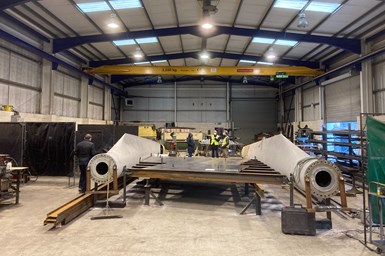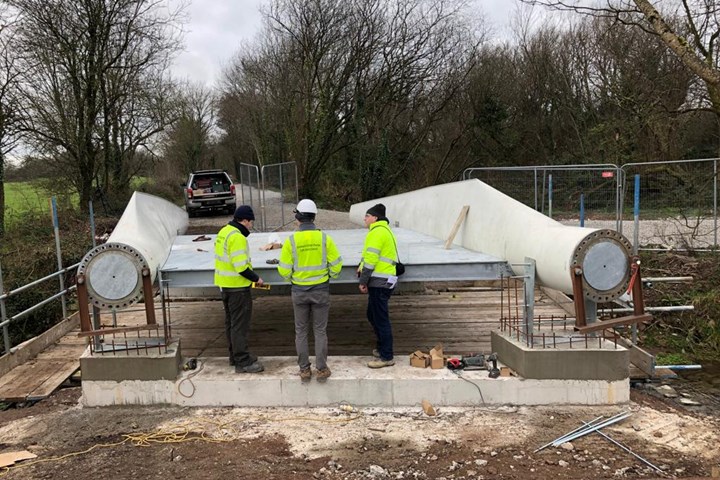Re-Wind Network successfully installs repurposed wind blade pedestrian bridge
The Ireland-based, five-meter-long BladeBridge solution has undergone extensive materials and mechanical testing to ensure application suitability.
On Jan. 26, the Re-Wind Network — comprising the University College Cork, Queens University Belfast, Georgia Tech and Munster Technological University (MTU) — announced the successful installation of a wind blade pedestrian bridge (BladeBridge) in Cork, Ireland, with remaining landscaping, removal of shoring platform underneath and handrail assembly to be completed shortly. The structure is one of two repurposed end-of-life (EOL) wind blade solutions initially designed and rendered in its fall 2021 Re:Wind Design catalogue, and was additionally designed to have the capacity and width to carry maintenance or emergency vehicles. Completion of the second demonstration, a wind blade power pole (BladePole) located in Kansas is planned for summer 2022.
The BladeBridge was originally funded in 2019 under the Irish Government Department of Transport’s “Project Ireland 2040” initiative, one of many opportunities identified by MTU to build a blade bridge on a long-distance pedestrian and cycle route in the Midleton-Youghal Greenway, a location which is under development by Cork County Council to improve rural development, tourism and public health. It uses two repurposed LM 13.4 wind blades from Nordex (Rockstock, Germany) N29 turbines originally donated by Everun Ltd. (Belfast, Northern Ireland) for its main girders. The remaining tip of the of the blade is embedded into the ground.
Final installation required experimental testing, computational modeling and design work to ensure the fiber-reinforced polymer (FRP) wind blades were suitable for use as girders for a short-span pedestrian bridge. Out of a total of eight blades donated by Everun, five were placed temporarily in storage, two were kept for the BladeBridge fabrication and one was delivered to the MTU structures laboratory for testing.
Extensive materials and mechanical testing, such as resin burnout tests (conducted in accordance with ASTM D2584 (ASTM 2011)) to determine how the material properties varied along the length of the blade, and mechanical testing in tension and compression were performed. Additionally, a four-point edgewise bending test was carried out on a four-meter section of the wind blade to evaluate its load-carrying behavior.
Software was also developed by the Re-Wind team called “BladeMachine” used to generate the engineering properties of the blade at multiple sections along the blade length. Preliminary designs considered architectural and structural requirements, including different orientations and placements of the wind blades (below deck, cable-stayed, etc.), connecting the stringers and deck to the blades and aesthetic details including the guardrail design, deck height, blade length and construction materials.
“This project would not have been possible without the vision and the enthusiastic support of the Cork County Council,” says Larry Bank, industry-academic outreach, The Re-Wind Network. “The Re-Wind Network is immensely proud of our Irish team at MTU and UCC led by Kieran Ruane and Angie Nagle.”
Related Content
Combining multifunctional thermoplastic composites, additive manufacturing for next-gen airframe structures
The DOMMINIO project combines AFP with 3D printed gyroid cores, embedded SHM sensors and smart materials for induction-driven disassembly of parts at end of life.
Read MoreTU Munich develops cuboidal conformable tanks using carbon fiber composites for increased hydrogen storage
Flat tank enabling standard platform for BEV and FCEV uses thermoplastic and thermoset composites, overwrapped skeleton design in pursuit of 25% more H2 storage.
Read MoreNatural fiber composites: Growing to fit sustainability needs
Led by global and industry-wide sustainability goals, commercial interest in flax and hemp fiber-reinforced composites grows into higher-performance, higher-volume applications.
Read MoreThe potential for thermoplastic composite nacelles
Collins Aerospace draws on global team, decades of experience to demonstrate large, curved AFP and welded structures for the next generation of aircraft.
Read MoreRead Next
“Structured air” TPS safeguards composite structures
Powered by an 85% air/15% pure polyimide aerogel, Blueshift’s novel material system protects structures during transient thermal events from -200°C to beyond 2400°C for rockets, battery boxes and more.
Read MoreVIDEO: High-volume processing for fiberglass components
Cannon Ergos, a company specializing in high-ton presses and equipment for composites fabrication and plastics processing, displayed automotive and industrial components at CAMX 2024.
Read MorePlant tour: Daher Shap’in TechCenter and composites production plant, Saint-Aignan-de-Grandlieu, France
Co-located R&D and production advance OOA thermosets, thermoplastics, welding, recycling and digital technologies for faster processing and certification of lighter, more sustainable composites.
Read More


























